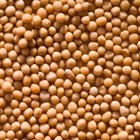
There's nothing quite like a big pot of soup bubbling away on the stove on a chilly day. Teamed with a salad and some crusty bread or homemade biscuits, your soup becomes the star attraction of a complete meal. Many soups, such as chicken noodle or vegetable soup, are broth-based, which means that the liquid they are prepared in is thin and clear. You can thicken most soups, however, by using one of several methods, which includes adding a slurry made of either flour or cornstarch.
First Things First
You can make many cream soups or chowders by starting with a roux, which is a blend of butter and flour cooked into a thick paste. You then add water or broth, and slowly simmer other ingredients, such as finely diced vegetables, meats or fish, until they are tender and the soup's thickness is to your liking. If it's still too thin, you can stir another roux in at the end of the cooking period, or add beurre manier, which is a lump of softened butter and flour that behaves the same as a roux. Whichever method you use, stir constantly until the soup reaches the consistency you want.
Slurring Things Up
You can use flour or cornstarch to thicken soup by first blending it with cold water or broth. Called a slurry, you then stir the thickened liquid slowly into the hot soup. A slurry made from equal parts flour and water is also called a white wash, since the flour may alter the color of the soup or stock. It takes about 1 tablespoon of flour to thicken 1 cup of broth. Blending the flour and water thoroughly with the water minimizes clumping when the slurry is stirred into hot soup. If you are using a cornstarch slurry, it will take about 2 ounces of cornstarch to an equal amount of water of water or broth to thicken 1 quart of liquid, and the thickening action only takes effect, once the soup starts to simmer.
All About Flour
When using flour to thick soups, the starch molecules absorb water or other cooking liquid, causing them to enlarge. Once you expose the flour and water mixture to heat, the molecules move around until they stabilize, thickening whatever liquid they are added to. If you cook the soup too long, the starches start to break down and to lose their thickening ability. As the soup cools, sometimes, the starches thicken even more. You can remedy this only by slowly reheating the soup until it returns to its original consistency.
All About Cornstarch
Cornstarch behaves the same as flour when used a thickener, but absorbs liquids much more readily and lends a clear shiny consistency to soups instead of the opaqueness that a flour thickener imparts. Cornstarch dissolves more readily in cold water or chilled broth, and is less likely to produce lumps in hot soup. You can substitute arrowroot for cornstarch, as they both produce similar results as a thickener that adds no flavor to soups. You can cook it longer, without losing its thickening ability, but you should not use it in cream soups, as it gives them a slimy texture.
Related Articles

Can You Thicken Soup With Xanthan Gum?

Tapioca Flour Vs. Quick Cooking Tapioca

Why Do Cream Soups Curdle and Turn Sour?

Corn Starch Vs. Rice Flour As ...
Can I Freeze Split Pea Soup With Ham ...
Can You Substitute Cornstarch for Flour?

How Do I Thicken Curry?

How to Make Cream Soup With Potato ...

What Can I Use to Thicken a Cream Sauce?

Can You Make Cream Soups Hours Before ...

How to Make French Sauce With Roux of ...

What Else Could You Use Besides Cream ...

Low Sodium Substitute for Condensed ...

How to Cook Lentils and Split Peas

Differences Between Tapioca Starch and ...

How to Keep Milk From Separating in ...

How to Get Half & Half to Thicken

How to Cook Seven Bean Soup

How to Add Noodles to Soup

Substitute for Manioc Starch
References
Writer Bio
Rachel Lovejoy has been writing professionally since 1990 and currently writes a weekly column entitled "From the Urban Wilderness" for the Journal Tribune in Biddeford, Maine, as well as short novellas for Amazon Kindle. Lovejoy graduated from the University of Southern Maine in 1996 with a Bachelor of Arts in English.
Photo Credits
Jupiterimages/liquidlibrary/Getty Images